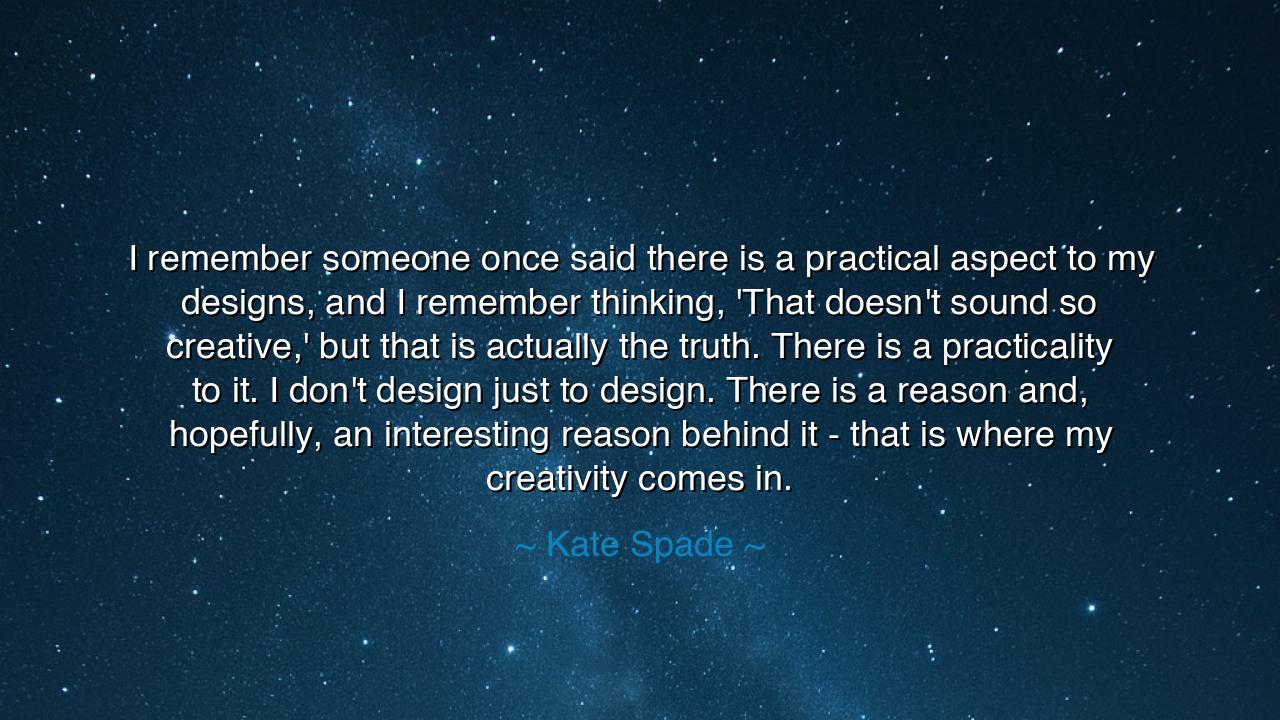
I remember someone once said there is a practical aspect to my
I remember someone once said there is a practical aspect to my designs, and I remember thinking, 'That doesn't sound so creative,' but that is actually the truth. There is a practicality to it. I don't design just to design. There is a reason and, hopefully, an interesting reason behind it - that is where my creativity comes in.






“I remember someone once said there is a practical aspect to my designs, and I remember thinking, ‘That doesn’t sound so creative,’ but that is actually the truth. There is a practicality to it. I don’t design just to design. There is a reason and, hopefully, an interesting reason behind it — that is where my creativity comes in.” – Kate Spade
In these graceful and grounded words, Kate Spade, a woman whose designs danced between elegance and ease, reveals the secret of true creativity — that it is not chaos in color, nor excess in ornament, but the marriage of purpose and imagination. When she speaks of practicality, she speaks not of limitation, but of harmony — of art that serves life rather than standing apart from it. To the untrained ear, practicality may seem dull, even unromantic. Yet to the wise creator, it is the vessel through which beauty endures and finds its place in the world.
From the beginning of civilization, the ancients understood this truth. The architects of Greece did not build temples for the sake of spectacle, but to house the divine. The artisans of Japan did not carve bowls merely for display, but to serve tea with grace and mindfulness. Their art was purposeful, and their purpose was art. So too did Kate Spade, in her time, craft designs that were not only lovely to behold but useful, accessible, and filled with intention. Her handbags, her garments, her patterns — they were not mere symbols of style; they were companions to the lives of those who wore them.
In her reflection lies a quiet rebellion against the empty pursuit of beauty for its own sake. She confesses that once, she too doubted the virtue of practicality — fearing it might rob her of creative freedom. Yet in time, she discovered the deeper magic: that creativity blooms most brightly when rooted in reason. A flower untethered from soil withers in the air; so too does art without purpose fade into self-indulgence. The greatest design, like the greatest life, must serve — it must carry meaning, solve problems, make existence a little kinder, lighter, or more beautiful for others.
Consider the story of Leonardo da Vinci, whose genius knew no boundary between art and science. He painted the human form with the same precision with which he designed flying machines and bridges. To him, practicality and creativity were twin forces, not rivals. He wrote, “Study the science of art, and the art of science.” It was this unity that made his work immortal — not merely beautiful, but functional, insightful, and centuries ahead of its time. In Leonardo’s hands, as in Spade’s, we see that true imagination does not escape reality; it elevates it.
Kate Spade’s wisdom also carries a moral truth about how we live. In an age where many chase spectacle — loudness without meaning, novelty without necessity — she reminds us that the purpose of creation is connection. Every meaningful act, whether it is designing a dress, building a bridge, or writing a letter, should spring from a reason both human and heartfelt. To design “just to design,” to act “just to act,” is to float without anchor. But when we ground our actions in intention — when we ask, “What good does this bring? Whom does this serve?” — we create not only beauty, but significance.
And yet, her words also contain warmth and humility. She does not claim to design from divine inspiration alone; she designs with people in mind, with practicality guiding her hand and creativity shaping her soul. This balance is the mark of a master. For it is easy to create for oneself, but noble to create for the world. She reminds us that art without empathy is decoration, while art with purpose becomes legacy.
So, dear listener and learner, take this truth into your heart: Creativity is not opposed to practicality — it is born from it. In whatever you make, whether a home, a poem, or a simple meal, let your imagination be guided by purpose. Ask not only how it looks, but why it matters. Find beauty in usefulness, and usefulness in beauty. For as Kate Spade teaches through her life and her craft, the most enduring creations are those that delight the eye while serving the hand, that touch both the mind and the heart.
In this way, you too may become a designer of life — one who lives with intention, creates with care, and leaves behind not just lovely things, but meaningful ones.






AAdministratorAdministrator
Welcome, honored guests. Please leave a comment, we will respond soon